I am running a regression problem on sensor data having four columns using the LSTM framework. I have not yet used any regularization.
The code I used specified below;
import numpy as np
import matplotlib.pyplot as plt
import pandas as pd
import math
import keras
from keras.models import Sequential
from keras.layers import Dense, Dropout, Activation
from keras.layers import LSTM
from sklearn.preprocessing import MinMaxScaler
from sklearn.metrics import mean_squared_error
from keras import callbacks
from keras.layers import Flatten
# load the dataset
gbx_data = pd.read_csv('/home/prm/Downloads/aggregated_vibration.csv', usecols=[4,5,6,7])
dataset = gbx_data.values
dataset = dataset.astype('float32')
scaler = MinMaxScaler(feature_range=(0, 1))
dataset = scaler.fit_transform(dataset)
train_size = int(len(dataset) * 0.63)
test_size = len(dataset) - train_size
train, test = dataset[0:train_size,:], dataset[train_size:len(dataset),:]
print(len(train), len(test))
def create_dataset(dataset, look_back):
dataX, dataY = [], []
for i in range(len(dataset)-look_back-1):
a = dataset[i:(i+look_back), :]
dataX.append(a)
dataY.append(dataset[i + look_back, :])
return np.array(dataX), np.array(dataY)
look_back = 10
trainX, trainY = create_dataset(train, look_back)
testX, testY = create_dataset(test, look_back)
trainX = trainX.reshape(trainX.shape[0], look_back, trainX.shape[2]) # model input shape & model output shape will be same always #
testX = testX.reshape(testX.shape[0], look_back, testX.shape[2])
batch_size = 120
class LossHistory(keras.callbacks.Callback):
def on_train_begin(self, logs={}):
self.losses = []
def on_epoch_end(self, epoch, logs={}):
self.losses.append(logs.get('loss'))
model=Sequential()
model.add(LSTM(10, return_sequences=True, input_shape=(look_back, 4), activation='relu'))
model.add(Dropout(0.2))
model.add(LSTM(12, return_sequences=True, input_shape=(look_back, 4), activation='relu'))
model.add(Dropout(0.2))
model.add(Flatten())
model.add(Dense(4, activation='relu'))
model.compile(loss='mean_squared_error', optimizer='adam', metrics=['accuracy'])
history = LossHistory()
model.fit(trainX, trainY, epochs=10, batch_size=batch_size, callbacks=[history])
print(history.losses)
I will like to know the specifications for the following questions;
- For each epoch end, i am getting the loss for the
LossHistoryclass. How can I get the weights after each epoch? I knowmodel.get_weights()gives me all the weights. But how can I get them after each epoch? - How can I optimally know which activation function I should use in LSTM & Dense layers so that my data performs 'best' & gives me good accuracy?
model.get_config()gives me'stateful': False. If I execute a statefull LSTM, what change will actually occur & checking which values I can understand the change?- If
return_sequences=Falsewhat change will occur? - How can I choose optimally the number of hidden nodes(neurons) for LSTM & Dense layer?
Running the above code, the loss history after 10 epochs are as follow,
[0.016399867401633194, 0.0029856997435597997, 0.0021351441705040426, 0.0016288172078515754, 0.0012535296516730061, 0.0010065438170736181, 0.00085688360991555948, 0.0007937529246583822, 0.00073356743746738303, 0.00069794598373472037]
with accuracy 77%.
I am adding the table of several iterative approaches as well.
Sorry If I asked a lot. Please share your assistance if possible.